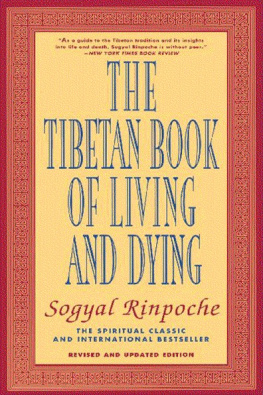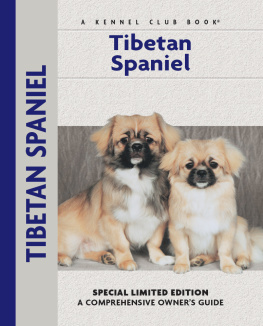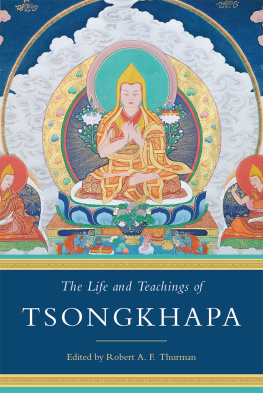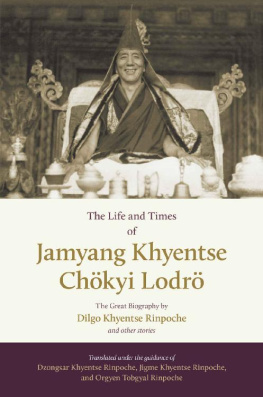O THER B OOKS BY C HGYAL N AMKHAI N ORBU
Dzog Chen and Zen
The Crystal and the Way of Light: Sutra, Tantra and Dzogchen
Drung, Deu and Bn
Journey Among the Tibetan Nomads: An Account of a Remote Civilization
Dream Yoga and the Practice of Natural Light
Dzogchen: The Self-Perfected State
The Mirror: Advice on the Presence of Awareness
The Supreme Source: The Fundamental Tantra of the Dzogchen Semde
(with Adriano Clemente)
Dzogchen Teachings
Yantra Yoga: The Tibetan Yoga of Movement
Birth, Life and Death According to Tibetan Medicine and the Dzogchen Teaching
Longchenpas Advice from the Heart
Rainbow Body: The Life and Realization of Togden Ugyen Tendzin
A History of Zhang Zhung and Tibet, Volume One: The Early Period
Healing with Fire: A Practical Manual of Tibetan Moxibustion
Copyright 2012 by Chgyal Namkhai Norbu.
All rights reserved. No portion of this book, except for brief review, may be reproduced, stored in a retrieval system, or transmitted in any form or by any meanselectronic, mechanical, photocopying, recording, or otherwisewithout the written permission of the publisher. For information contact North Atlantic Books.
Published by
North Atlantic Books
P.O. Box 12327
Berkeley, California 94712
and
Shang Shung Publications
Localit Merigar
58031 Arcidosso (GR), Italy
www.shangshungpublications.org
Cover photo by Master Bi Song
Cover design by Daniel Zegunis
The Lamp That Enlightens Narrow Minds: The Life and Times of a Realized Tibetan Master, Khyentse Chkyi Wangchug is sponsored by the Society for the Study of Native Arts and Sciences, a nonprofit educational corporation whose goals are to develop an educational and cross-cultural perspective linking various scientific, social, and artistic fields; to nurture a holistic view of arts, sciences, humanities, and healing; and to publish and distribute literature on the relationship of mind, body, and nature.
North Atlantic Books publications are available through most bookstores. For further information, visit our website at www.northatlanticbooks.com or call 800-733-3000.
Library of Congress Cataloging-in-Publication Data
Chgyal Namkhai Norbu, b. 1938
The lamp that enlightens narrow minds: the life and times of a realized Tibetan master, Khyentse Chkyi Wangchug / Chgyal Namkhai Norbu; translated from Tibetan into Italian, edited, and annotated by Enrico DellAngelo.
pages cm
Includes translation from Tibetan.
Summary: A valuable reference for followers of Tibetan Buddhism and people interested in Tibetan culture, The Lamp That Enlightens Narrow Minds recounts the remarkable life of Tibetan master Khyentse Chkyi Wangchug and presents a vivid description of Tibet in the years leading up to its annexation by China.Provided by publisher.
eISBN: 978-1-58394-528-5
1. Chos-kyi-dban-phyug, 19091960. 2. Reincarnate lamasChinaTibet Autonomous RegionBiography. 3. BuddhismChinaTibet Autonomous RegionHistory20th century. 4. Tibet Autonomous Region (China)History20th century. I. DellAngelo, Enrico, translator from the Tibetan into Italian, writer of added commentary. II. Title.
BQ946.O753N36 2012
294.3923092dc23
[B]
2011050959
IPC - 716EN12 - Approved by the International Publications Committee of the Dzogchen Community founded by Chgyal Namkhai Norbu
v3.1
 Contents
Contents Illustrations
IllustrationsJamyang Khyentse Wangpo (artist unknown)
Khenpo Khyenrab Chkyi ser (photographer unknown)
Footprint of Jamyang Khyentse Wangpo (photo by Enrico DellAngelo)
Khyentse Chkyi Wangchug (photographer unknown; photo belonging to Chgyal Namkhai Norbu)
Khyentse Chkyi Lodr (photographer unknown; photo belonging to Chgyal Namkhai Norbu; has the fingerprint of Khyentse Chkyi Lodr on its back)
Khyentse Chkyi Lodr, Palpung Situ, Khenpo Zhenga, and Jamgyal Rinpoche (photo kindly provided by Tubten Nyima Rinpoche [Alak Zenkar])
Dzongsar monastery (photo kindly provided by Tubten Nyima Rinpoche [Alak Zenkar])
Chag Tobden (photographer unknown; photo belonging to Chgyal Namkhai Norbu)
The Gagu hermitage (photo by Enrico DellAngelo)
Derge Gnchen: the palace of the king (photographer unknown)
unknown; photo found and photographed by the translator in the kitchen of Dege Gonchen)
Galingteng (photo by Enrico DellAngelo)
Views of Galingteng (photo by Enrico DellAngelo)
Frescoes depicting protectors of the doctrine in the Mahkla temple at Galingteng (photo by Enrico DellAngelo)
Statue of Vajrapi, terma of Lhalung (photo by Khyentse Yeshe)
Drugpa Khenpo Ngawang Lodr (photographer unknown)
Khyentse Chkyi Lodr (photographer unknown; photo belonging to Chgyal Namkhai Norbu)
The ruins of Lhari Phodrang (photo by Andrea DellAngelo)
The sixth Dzogchen Rinpoche (photographer unknown)
Shechen Rabjam (photographer unknown)
Chgyal Namkhai Norbu, Khyentse Yeshe, and Yuchen Namkhai (photo by Nicoletta Liguori)
 Translators Introduction
Translators IntroductionT HIS BIOGRAPHY of Lama Jamyang Khyentse Chkyi Wangchug, also known as Chkyi Wangchug and Khyentse Rinpoche, was written in 1985 by his nephew Chgyal Namkhai Norbu, who based his account on personal recollections, notes taken during his youth, and the reminiscences of other people who were close to the master. The biography was revised and completed by its author in 1999.
This work belongs to an important category of Tibetan literature called namthar, a literary form that includes countless texts, such as the biography of Milarepa, now famous in the West as well, that have inspired generations of devout Buddhists in Tibet. Namtharsbiographies, or more precisely hagiographiesbesides recording biographical data, often introduce the reader to the deep meaning of the spiritual practices of realized masters.
Written entirely in verse, the biography of Chkyi Wangchug, though not far in its general structure from the namthar genre, is distinguished by its particularly lively narrative approach, due partially to the authors eyewitness accounts of some of the episodes, and above all to the authors close relationship with Khyentse Rinpoche and with the people who knew him. That Chkyi Wangchug was not only one of his principal masters but also his maternal uncle made Chgyal Namkhai Norbu a privileged observer, thus affording him an understanding of events not feasible for others.
The narration of the life of Khyentse Rinpoche, intriguing for the general reader with its abundance of extraordinary events and vivid description of a world irredeemably lost following the Chinese annexation, certainly will be a font of inspiration for those linked to the lineage of this master and to the transmission of his teachings.













 Contents
Contents